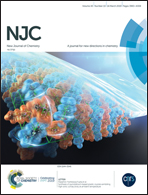Design, synthesis and properties of hemiphasmidic luminescent liquid crystal polymers with the AIEE effect†
Abstract
Two series of hemiphasmidic luminescent liquid crystal polymers with different numbers and different lengths of the terminal alkoxy chains, named poly{(Z)-4-(2-(3,5-bis(alkoxy)phenyl)-2-cyanovinyl)phenyl methacrylate} and poly{(Z)-4-(2-cyano-2-(3,4,5-tris(alkoxy)phenyl)vinyl)phenyl methacrylate} (denoted as P2-m and P3-m, m = 4, 8, and 12), were synthesized via free radical polymerization. For comparison, rod-like side chain liquid crystal polymers without a flexible spacer, named {(Z)-4-(2-cyano-2-(4-(octyloxy)phenyl)vinyl)phenyl methacrylate} (denoted as P1-m, m = 4, 8, 12), were also prepared. The phase structures and photophysical properties of the polymers were investigated in detail by a combination of techniques including differential scanning calorimetry (DSC), polarized optical microscopy (POM), 1D wide-angle X-ray diffraction (1D WXRD), small-angle X-ray scattering (SAXS), UV absorption spectroscopy (UV spectroscopy) and photoluminescence spectroscopy (PL spectroscopy). The results revealed that the phase structure and the aggregation-induced emission enhancement (AIEE) effect of these novel luminescent liquid crystalline polymers bearing cyanostilbene as the rigid core could be effectively regulated by adjusting the number and the length of the terminal alkoxy chains. With an increase in the number and the length of the terminal alkoxy chains, the “spatial volume effect” caused by the terminal alkoxy chains would increase, which makes the polymers undergo a transition process from an ordinary smectic phase to a smectic phase with small liquid crystal domains, and then to a hexagonal columnar phase. Meantime, the AIEE effect and the solid state fluorescence quantum yield also increased with increasing “spatial volume effect”.



 Please wait while we load your content...
Please wait while we load your content...